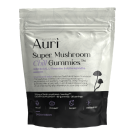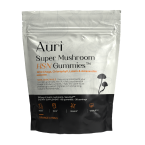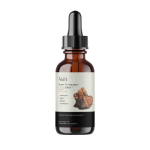Pektin- vs. Gelatine-Gummibärchen: Die Wahl des perfekten Kaubonbons

Gummibärchen sind für viele eine beliebte süße Leckerei, die eine Geschmacksexplosion in einer lustigen, zähen Form bietet.
Die Geschichte der Gummibärchen reicht bis ins frühe 20. Jahrhundert zurück, als Hans Riegel sen. den ersten Gummibärchen in Deutschland aus Gelatine erfand.
Im Laufe der Jahre hat die Popularität von Gummibärchen aufgrund ihrer Vielseitigkeit und großen Beliebtheit stark zugenommen. Die zunehmende Beliebtheit veganer und vegetarischer Ernährung hat das Interesse an alternativen Geliermitteln wie Pektin weiter verstärkt, insbesondere bei denjenigen, die vegane Gummibärchen suchen.
Warum ist das wichtig?
Die Wahl zwischen Pektin und Gelatine als Geliermittel kann die Textur, den Geschmack und die diätetische Eignung dieser Süßigkeiten erheblich beeinflussen.
In diesem Blogbeitrag untersuchen wir die Unterschiede zwischen Pektin- und Gelatinegummis, einschließlich ihrer Vorteile, Nährwertprofile und Auswirkungen auf die Umwelt, um Ihnen bei der Auswahl des perfekten Kausnacks zu helfen.
Pektin verstehen
Pektin ist ein natürliches Polysaccharid, das in den Zellwänden von Früchten vorkommt. Es wird üblicherweise aus Zitrusfrüchten und Äpfeln gewonnen.
Kommerzielles Pektin wird hauptsächlich aus Zitrusschalen und Apfeltrester gewonnen. Diese pektinreichen Quellen sind Nebenprodukte der Saftherstellung und daher eine umweltfreundliche Option.
Pektin ist bekannt für seine Fähigkeit, in Kombination mit Zucker und Säure zu gelieren. Dies macht es zu einem idealen Geliermittel für die Herstellung leckerer Gummibärchen. Pektin bietet im Vergleich zu Gelatine eine feste und etwas weniger zähe Textur.
Verwendung bei der Gummibärchenherstellung
Pektin wird häufig in der Gummibärchenherstellung verwendet, da es bei Raumtemperatur ein stabiles Gel bildet. Besonders beliebt ist es in veganen Gummibärchen, da es auf tierische Inhaltsstoffe verzichtet.
Gelatine erforschen
Gelatine ist ein Protein, das aus dem Kollagen von Tierknochen, Haut und Bindegewebe gewonnen wird. Es ist ein traditionelles Geliermittel in Süßwaren.
Gelatine wird aus Knochen, Häuten und Bindegewebe von Kühen und Schweinen gewonnen. Daher ist sie für Menschen mit veganer oder vegetarischer Ernährung ungeeignet.
Gelatine ist für ihre hervorragenden Geliereigenschaften bekannt und sorgt für eine zähe und elastische Textur, die bei der traditionellen Gummibärchenherstellung sehr beliebt ist.
Anwendungen in der Gummibärchenproduktion
Gelatine wird in verschiedenen Süßwaren verwendet, darunter Gummibärchen, Marshmallows und Gelees. Ihre Fähigkeit, schnell zu gelieren und ihre Stabilität unter verschiedenen Bedingungen machen sie zu einer beliebten Wahl.
Hauptunterschiede zwischen Pektin und Gelatine
Die Wahl zwischen Pektin und Gelatine als Geliermittel kann die Eigenschaften des Endprodukts stark beeinflussen. Das Verständnis der wichtigsten Unterschiede hilft Ihnen, eine fundierte Entscheidung für Ihre Gummibärchenherstellung zu treffen.
Nachfolgend finden Sie eine Tabelle mit den wichtigsten Unterschieden zwischen Pektin und Gelatine:
|
Aspekt |
Pektin |
Gelatine |
|
Chemische Zusammensetzung |
Pektin ist ein Kohlenhydrat. |
Gelatine ist ein Protein. |
|
Geliereigenschaften |
Aktiviert durch Zucker und Säure. |
Bildet beim Abkühlen ein Gel, nachdem es in einer heißen Flüssigkeit aufgelöst wurde. |
|
Textur und Mundgefühl |
Fest und weniger zäh. |
Elastisch und zäh. |
|
Ernährungspräferenzen |
Geeignet für vegane und vegetarische Ernährung. |
Aufgrund tierischer Herkunft nicht für Veganer oder Vegetarier geeignet. |
|
Geschmacksvielfalt |
Funktioniert gut mit natürlichen Farben und Aromen. |
Begrenzte Kombinationsmöglichkeiten mit bestimmten natürlichen Aromen. |
|
Temperatursensitivität |
Empfindlich gegenüber hohen Temperaturen, die die Stabilität beeinträchtigen können. |
Stabil unter verschiedenen Temperaturbedingungen. |
|
Umweltauswirkungen |
Nachhaltiger, da aus Fruchtnebenprodukten gewonnen. |
Höherer ökologischer Fußabdruck, da tierische Produkte verwendet werden. |
Jeder Faktor ist wichtig, um zu bestimmen, ob Pektin oder Gelatine die beste Wahl für Ihre Gummiformel ist.
Nährwertvergleich
Bei der Wahl zwischen Pektin- und Gelatine-Gummis ist es wichtig, deren Nährwertprofile zu berücksichtigen. Der Nährstoffgehalt beider Gummiarten kann je nach Rezeptur und verwendeten Zutaten variieren.
Wenn Sie die ernährungsphysiologischen Unterschiede zwischen Pektin- und Gelatinegummis kennen, können Sie besser entscheiden, welche Sorte am besten zu Ihren Ernährungsbedürfnissen passt.
Kaloriengehalt
Sowohl Pektin- als auch Gelatinegummis haben einen ähnlichen Kaloriengehalt, der hauptsächlich durch die zugesetzten Zucker und Aromen bestimmt wird.
Ballaststoffgehalt
Pektingummis enthalten aufgrund der Pflanzenextrakte Ballaststoffe, die in Gelatinegummis nicht enthalten sind. Dies kann zusätzliche gesundheitliche Vorteile bieten, wie beispielsweise eine verbesserte Verdauung.
Proteingehalt
Gummibärchen mit Gelatine enthalten aufgrund des Kollagens Protein, während Gummibärchen mit Pektin keinen nennenswerten Proteingehalt aufweisen.
Vitamingehalt
Pektinbasierte Gummibärchen können oft mit Vitaminen angereichert werden, insbesondere da sie aus Früchten gewonnen werden. Das macht sie zu einer hervorragenden Option für alle, die ihre Vitaminzufuhr steigern und gleichzeitig eine süße Leckerei genießen möchten.
Zuckergehalt
Der Zuckergehalt sowohl in Pektin- als auch in Gelatine-Gummis hängt von der Rezeptur ab. Pektin ermöglicht eine größere Bandbreite an Zuckergehalten, was für zuckerarme Rezepturen von Vorteil sein kann.
Die Wahl des richtigen Typs hängt von Ihren spezifischen Ernährungsbedürfnissen ab.
Bei Auri Nutrition stellen wir leckere und nahrhafte Pilzgummis aus dem Fruchtkörper des Pilzes her, dem besten Teil des Pilzes mit dem höchsten Nährwert. Unsere Pilzgummis werden aus fachmännisch ausgewählten Rohstoffen hergestellt und durchlaufen Verkostungsrunden, um einen köstlichen und gesundheitsfördernden Genuss zu bieten.
Entdecken Sie unsere Gummibärchen-Kollektion
Zu berücksichtigende Faktoren bei der Wahl zwischen Pektin- und Gelatinegummis
Versuchen Sie, Gummibärchen mit der besten Textur, dem besten Geschmack und der besten Ernährungsverträglichkeit auszuwählen?
Hier sind die wichtigsten Faktoren, die Sie berücksichtigen sollten, um sicherzustellen, dass Sie eine fundierte Entscheidung treffen, die Ihren Bedürfnissen und Vorlieben entspricht.
Diätetische Einschränkungen
Pektin ist die klare Wahl für Menschen, die aufgrund ihrer Ernährung auf tierische Produkte verzichten müssen.
Texturpräferenz
Gelatine sorgt für eine traditionelle zähe Textur, während Pektin für einen festeren Biss sorgt.
Überlegungen zur Haltbarkeit
Sowohl Pektin- als auch Gelatinegummis haben eine gute Haltbarkeit, aber die Stabilität von Pektin bei Raumtemperatur kann von Vorteil sein.
Vergleich der Herstellungsverfahren
Wenn Sie den Herstellungsprozess von Pektin- und Gelatinegummis verstehen, können Sie leichter feststellen, welche Methode am besten zu Ihren Produktionsmöglichkeiten und -zielen passt.
Jeder Prozess umfasst spezifische Schritte und Geräte, um die gewünschte gummiartige Textur und Qualität zu erreichen.
Hier sind die detaillierten Schritte zur Herstellung jedes Typs:
Herstellung von Pektingummi
- Zubereitung: Pektin mit Zucker und Säure in Wasser auflösen.
- Erhitzen: Kochen Sie die Mischung, um das Pektin zu aktivieren.
- Formen: In Formen gießen und fest werden lassen.
Diese Schritte führen zu festen und stabilen Gummis. Die Herstellung von Pektingummis erfordert Standard-Süßwarengeräte, einschließlich Mischer und Formen.
Herstellung von Gelatinegummi
- Hydratisierung: Gelatine in Wasser einweichen, bis sie aufquillt.
- Erhitzen: Aufgequollene Gelatine in einer erhitzten Mischung aus Wasser, Zucker und Aromen auflösen.
- Formen: In Formen gießen und fest werden lassen.
Diese Schritte sorgen dafür, dass die Gummibärchen eine elastische und zähe Konsistenz haben. Für die Herstellung von Gelatinegummis sind außerdem Mischer, Formen und temperaturkontrollierte Umgebungen erforderlich.
Aroma- und Farboptionen
Sowohl Pektin- als auch Gelatine-Gummis können mit natürlichen Farb- und Aromastoffen angereichert werden, was ihre Attraktivität deutlich steigert und gesundheitsbewusste Verbraucher anspricht. Natürliche Optionen wie Fruchtextrakte und Gemüsesäfte sorgen für leuchtende Farben und authentischen Geschmack und machen die Gummis attraktiver und gesünder.
Obwohl auch künstliche Aromen und Farbstoffe verwendet werden können, bevorzugen viele Verbraucher aufgrund ihrer gesundheitlichen Vorteile und der minimalen chemischen Zusätze natürliche Zutaten.
Umweltauswirkungen
Pektin wird aus nachwachsenden Pflanzen gewonnen und fällt als Nebenprodukt der Fruchtsaftindustrie an. Dadurch ist es nachhaltiger als Gelatine, deren Herstellung auf ressourcenintensiver Tierhaltung beruht.
Bei Auri Nutrition legen wir bei unserer Pektinproduktion Wert auf nachhaltige Herstellungsverfahren, um unseren ökologischen Fußabdruck weiter zu reduzieren.
Darüber hinaus sollte die Verpackung von Pektin- und Gelatine-Gummis vor allem biologisch abbaubar sein, um die Umweltbelastung zu minimieren. Auri verwendet nachhaltige Verpackungsmaterialien, um Abfall zu reduzieren und einen umweltfreundlicheren Produktlebenszyklus zu unterstützen.
Gesundheitliche Aspekte
Bei der Wahl zwischen Pektin- und Gelatine-Gummibärchen ist es wichtig, deren gesundheitliche Auswirkungen zu berücksichtigen. Hier sind die wichtigsten gesundheitlichen Aspekte, die Sie beachten sollten:
Allergeninformationen
Pektin ist im Allgemeinen hypoallergen und daher für die meisten Menschen eine sichere Wahl. Personen mit spezifischen Allergien gegen Kollagen oder bestimmte tierische Inhaltsstoffe sollten Gelatine meiden.
Verdaulichkeit
Pektin ist leicht verdaulich und enthält zusätzliche Ballaststoffe, die die Darmgesundheit fördern und die Verdauung unterstützen. Gelatine hingegen ist proteinreich und wirkt sich positiv auf die Gelenkgesundheit aus, unterstützt die Knorpelreparatur und lindert Entzündungen.
Nährstoffaufnahme
Pektin kann die Aufnahme bestimmter Nährstoffe regulieren, den Verdauungsprozess verlangsamen und eine bessere Nährstoffaufnahme ermöglichen. Gelatine hingegen kann die Aufnahme von Proteinen und Mineralien verbessern und so zu einer verbesserten Gesamternährung beitragen.
Kulinarische Anwendungen jenseits von Gummibärchen
Pektin wird häufig zur Herstellung von Marmelade und Gelees verwendet, da es diesen Produkten die nötige Gelierung verleiht. Darüber hinaus wird es häufig in Fruchtkonserven und als Verdickungsmittel in verschiedenen Soßen und Dressings eingesetzt.
Gelatine wird in verschiedenen Desserts wie Marshmallows und Panna Cotta sowie in herzhaften Gerichten wie Aspik verwendet . Darüber hinaus ist sie eine wichtige Zutat bei der Herstellung von Mousse, Schlagsahne und bestimmten Puddings und trägt zu deren glatter und stabiler Textur bei.
Die richtige Wahl für Ihren Gummibedarf
Im Kampf zwischen Pektin- und Gelatinegummis hängt die richtige Wahl von Ihren Ernährungsvorlieben, Ihren Texturvorlieben und Umweltaspekten ab.
Pektin bietet eine veganfreundliche, nachhaltige Option mit vielseitigen Geschmacksmöglichkeiten und ist damit eine hervorragende Wahl für moderne Verbraucher, die nach gesünderen und ethischeren Süßigkeiten suchen.
Gelatine ist zwar traditionell und wegen ihrer Bissfestigkeit beliebt, eignet sich jedoch nicht für eine vegane Ernährung und hat einen höheren ökologischen Fußabdruck.
Wenn Sie diese wesentlichen Unterschiede verstehen, können Sie eine fundierte Entscheidung treffen, die Ihren Werten und Geschmacksvorlieben entspricht.
Wenn Sie Ihr allgemeines Wohlbefinden mit Pilzpräparaten unterstützen möchten, probieren Sie die Pilzgummis von Auri.
Unsere aromatischen Pilzgummis bieten Ihnen alle Vorteile einer vollen Schüssel Pilze, ohne den unangenehmen Pilzgeschmack. Vollgepackt mit Nährstoffen machen es unsere Gummis leicht, die Kraft der Pilze in Ihren Alltag zu integrieren.










